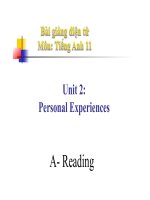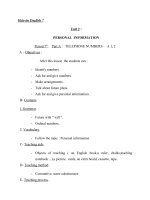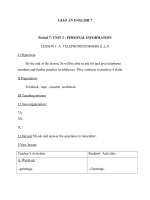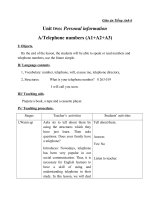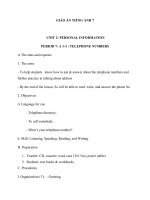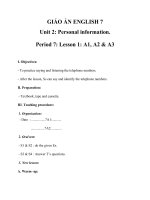Giáo án Tiếng Anh 11 Unit 2: Personal experiences
Bạn đang xem bản rút gọn của tài liệu. Xem và tải ngay bản đầy đủ của tài liệu tại đây (193.63 KB, 31 trang )
Giáo án Tiếng Anh 11
UNIT 2: PERSONAL EXPERIENCES
Reading
I. AIMS OF THE LESSON:
- Develop such reading micro-skill as scanning for specific ideas, identifying
the sequence of events and guessing meaning in context.
-Use the information they have read to discuss the story.
II. TEACHING AIDS: cassette player, tape, chalks, pictures, handouts, charts,
real objects if possible
III. TEACHING METHOD: communicative approach
IV. PROCEDURE:
STAGES TEACHER’S ACTIVITIES
STUDENTS’ ACTIVITIES
NOTES
Warm-
Ask Ss some questions about
Individua
up(4)
their most unforgettable
l
experience
1. When did it happen?
2. Where did it happen?
3. Who was involved?
4. How did it happen?
5. How did affect you?
Get Ss to work in pairs and
Pre-
try to make sense of the
Reading
pictures on pages 22. Then T
(5’)
gets them to put the pictures
in the order that they think is
most appropriate.
Look at the pictures and
Pairwork
guess what is happening in
each of them.
T elicits their answers by
asking questions and giving
prompts.
1. What can you see in the
picture A?
2. What do you see on the
table?
3. Whose money do you think
it is? Why?
Pre-teaching Vocabulary
1. embarrass (v) = make sb
confused or ashamed
- embarrassed(adj)
- embarrassing(adj)
- embarrassment(n)
2. experience(n) = event or
situation that affects sb in
Whole
class
some way
3. idol(n) = someone greatly
loved or admired
4. glance (n/v) = look at
somebody quickly
- glance at sb/sth
5. Be busy doing sth
- Be busy with something
6. note(n) : banknote
7. make a fuss = make an
important thing important or
more important
8. sneak (adj)
Ex: I’m sorry. I can’t go with
you now. I am busy with my
homework. I’m busy doing
my homework.
Ex: Do you want the money
in the notes or coins?
Play the cassette and ask Ss
to listen
WhileReading
Task 1
Get Ss to read the passage
Individua
l work &
(24’)
silently and then do task 1
Answers
whole
Check the answers with the
1. glanced
whole class.
2. making a fuss
class
3. embarrassing
4. idols
5. sneaky
Task 2
Get Ss to read the text silently Answers:
again and then with a peer
work out the sequence of the
pictures given on page 22
1. d
4. f
2.b
5. e
Individua
3.c
6.a
again.
Call on a student to give and
explain his / her answer.
Give corrective feedback.
Task 3
-Ask students to read the
questions in task 3 and
answer them in groups.
Suggested answers:
1. She wished to have a red
hat-a floppy cotton hat ( like
the one her star idol wore in
her video clip)
- Ask representative of each
2…...so that she could buy
group to give oral answers
the hat (for herself.)
and write them on the board.
3. She saw a wad of dollar
l& pair
work
notes (exactly like the one
that her father had given her).
4. Because she thought the
boy had stolen her money / it
was her money.
- Give feedback
5. She bought the pretty hat
of her dream.
Post
-Ask students to discuss the
reading
questions in group:
(10’)
1. How did the girl in the
story feel when she
discovered that the money
she had taken was not hers?
(embarrassed, sad,
ashamed, unhappy, terrible,
uncomfortable, anxious, …)
2. What did the girl have to
do (when she discovered that
the money she had taken was
not hers )?
( put a notice on T.V or at
school, get on the same bus
on the next day to look for
- Discuss in groups
Groupwork
him, do nothing, keep it a
secret, tell her father
everything and ask him for
advice,…)
- Ask some students to
- Report before class
represent their talk in front of
class
V. HOMEWORK: (2’)
- Write down the questions and the answers in the notebooks
- Study new words.
- Do the tasks in the notebooks.
- Prepare Speaking.
UNIT 2: PERSONAL EXPERIENCES
Speaking
I. AIMS OF THE LESSON:
1. Language skills:
• Speaking:
Identify structures that are used to talk about past experiences
and their
influences on one’s life.
2. Language focus :
Grammars: - present perfect and past simple
- structure with “make”
II. TEACHING AIDS: textbook, handouts.
III. TEACHING METHOD: communicative approach
IV. PROCEDURE:
STAGES TEACHER’S ACTIVITIES
Warmup(5’)
“Have you ever” Game
T divides the class into
groups of 3-4. Then T models
“Have you ever” + PP” for Ss
as well as ways to respond to
STUDENTS’ ACTIVITIES
NOTES
Group
work
“Have you ever” questions.
- Have you ever seen ghosts?
- Have you ever been to Da
Lat?
Individua
- Give answers
l
- Have you ever sung in
public?
- Have you ever spoken
English to you friends
(teachers, foreigners…)?
- How did you feel when you
spoke English to them?
Task 1
PreSpeaking T introduces the task and gets
Ss to do it individually, then
(5’)
compare the answers with a
Match the things you might
peer.
T calls on a student to read
his answers.
have done or experienced in
box A with how the
experience might have
affected you in box B.
T introduces the structure
Make + sb + V
Ex: He made me work hard
Individua
l/ pair
work
Make + sb + adj
T gives the feedback.
Ex: Don’t make her sad.
Suggested answers:
WhileSpeaking
(20’)
1. d
2. c
3. a
4. d
5. e
Task 2
Present perfect: used with
Ex: Have you ever been to Ha Whole
“ever” to talk about a past
Noi?
experience.
class
Ex: When did you go there?
Past simple: used when one
Who did you go with?
keeps asking about that
Did you enjoy your visit
experience.
in Ha Noi?
Ask Ss to work individually
on the sequence of the
conversation and then find a
peer to compare their answers
with.
Check with the class and give
corrective feedback.
Post
Task 3
Suggested answers:
3. h
4. a
7. c
8. f
5. e
6. g
speaking
(10’)
- Give students useful
structures
+ Have you ever………….?
+ How did it happen?
+ When/ Where did it
happen?
+ How did the experience
Pairwork
affect you? / How did you
feel?
Get Ss to ask and answer
questions about their
experiences, using the
suggested questions on page
26.
T goes around to check and
offer help.
T calls on some pairs to
perform their conversation in
front of the class.
T elicits feedback from the
class and gives final
comments.
Suggested conversations:
1.
A. Have you ever failed an
exam?
- Yes, I have.
B. How did it happen?
- I didn’t study well enough
for exam.
C. When did it happen?
- Last year.
D. How did you feel/ How
did it affect you?
- I felt disappointed/ sad/
depressed.
2.
A. Have you ever traveled to
other parts of the country?
- Yes, I have.
B. When did you travel?
- In 2002.
C. How did it affect you?
- It made me love our country
more / I learned more about
different places in our
country.
3.
A. Have you ever talked to a
famous pop star?
- Yes, I have.
B. Where did you meet him/
her?
- At a party
C. How did it affect you?
- It was interesting to talk to
famous pop stars.
- It changed my attitude to/
towards/ famous pop stars.
Wrappin
Whole
g up(3’)
work
T summarises the main points
of the lesson.
V. HOMEWORK:
- Write a paragraph about a past event that has had an influence on you.
- Learn by heart some new words.
- Prepare part C: Listening
UNIT 2: PERSONAL EXPERIENCES
Listening
I. AIMS OF THE LESSON:
1. Language skills:
• Listening :
- Develop such listening micro-skills as intensive listening for
specific information and taking notes while listening.
- Help students improve their listening skill.
- Help them understand the conversation and do Task 1,2
2. Language focus :
Vocabulary: memorable, scream, gas stove, escape, terrified,
replaced, embraced, protected.
II. TEACHING AIDs: cassette player, tape, chalks, pictures, handouts.
III. TEACHING METHOD: communicative approach
IV. PROCEDURE:
STAGES TEACHER’S ACTIVITIES
STUDENTS’ ACTIVITIES
NOTES
Warm-
Match the words in Column
Group
A with their definitions in
work
up(5’)
A matching Game
Column A
1. Fire fighter
Column B
2. Fire door
3. Smoke
4. Fire alarm
Column B
a. What comes out of a
fire
Answers
b. A fire-resitant door that
can be closed to stop
the spead of a fire
c. A person who fights
fires
Prelistening
(10’)
1. c
2. b
3. a
4. d
d. A bell that tells you a
fire has started.
Pair
T gets Ss to work in pairs to
work
describe the picture on page
27 of the textbook.
+ What can you see in the
picture?
+ What is happening?
(The house is burning. / The
house is on fire. /…..)
- Give theirs answers
+ Who are these people?
+ What is she doing?
( She’s talking a little girl out
of the burning house )
Pre-teaching vocabulary
-memory(n) the faculty of the
mind
- Listen and repeat in chorus
memorable(a) worthy to
be remembered
memorize(v)
- scream(v) cry out with a
shrill voice
- replace(v) place again
- embrace(v) fasten on
-escape(v) avoid the notice of
- protect(v) preserve
Ex: They escaped the search
protection(n)
of the enemy.
- gas stove(n) beáp ga
- terrified(a) frightened
- Ask students to repeat the
provided words and explain
the words if necessary
WhileListening
(20’)
Task 1
- Ask students to read Task 1
silently
- Read Task 1
- Listen to the tape and decide
- Ask students to listen to the
whether the statements are
tape twice.
true or false
- Ask students to do Task 1
Suggested answers:
individually.
1. T
- Read the sentences again to
2. F( 13 years ago)
help weak students:
3. F( in the kitchen)
1. We talk to Christina, a
successful business woman
2. My most unforgettable
experience happened 13 years
ago
3. The fire started in the
kitchen where I forgot to turn
off the gas stove.
4. I was sleeping, when I was
suddenly woke up by terrible
heat.
4. F( she was sleeping)
5. T
5. I heard my mother’s voice
calling my name.
- Give answers and take notes
- Give feedback
Task 2
- Ask students to read Task 2
silently and listen to the tape
- Listen and do Task 2
again.
- Ask two students to write
the answers on the board
- Give answers and take notes
- Give feedback
1. small
2. everything
3. family
4. replaced
5. took
6. appreciate
Post
T teaches Ss some useful
listening
expressions of asking for and
(7’)
giving opinions.
Asking for opinions
•
What do you think
Groupwork &
whole
class
about…?
•
What’s your opinion
about…?
•
What’s your feeling
about…?
•
How do you feel
about…?
Expressing opinions
I think / believe /
feel….
In my opinion,
…
From my point
of view…
Expressing agreements
♦ I agree / think so
♦ That’s right / true, and…
Expressing disageements
o Well, maybe, but…
o That might be true, but….
o Well, I don’t think so. I
thin
k…
T divides the class into small
groups of 3 or 4 and gets
them to discuss the question
in the textbook.
T goes around to check and
offer help.
V. WRAPPING UP (2’)
T summarises the main points of the lesson.
Ss write a summary of the story they listened in class.
T asks Ss to learn by heart all new words and do the extra exercise as homework.
T asks Ss to prepare Writing.
UNIT 2: PERSONAL EXPERIENCES
Writing
I. OBJECTIVES:
Write a personal letter telling about a past experience, using the
structures and vocabulary that they have learned in previous lessons.
II. TEACHING AIDS: textbook, handouts.
III. TEACHING METHOD: communicative approach
IV. PROCEDURE:
STAGES TEACHER’S ACTIVITIES
STUDENTS’ ACTIVITIES
NOTES
Warm-
A quiz about wrting
Whole
up(5’)
personal letters
class
T divides the class into 2 big
groups: A and B
T reads out the questions and
leads the games.
The Quiz
1. How many parts does a
Answers
personal letter have?
1. 5 parts
2. What are they?
2. The Heading. The greeting,
the Body, the Closing and the
Signature
3. What do we usually write
3. “Dear”, “Hello”, “Hi”… +
in the greeting?
the name of the person we are
writing to and a coma at the
end.
4. What do we usually write
in the Closing?
4. “Sincerely”, “Yours”,
“Love”, “Cheers”, “Best
wishes”…and after that we
5. Where do we sign the
put a coma.
letter?
5. under the Closing
- Have students give some of
Pre-
their past experiences?( being
writing
seriously ill, failing an exam;
talking to a famous pop star,
(8’)
… etc
While-
- Ask students to write a letter Write a passage about the
Individua
writing
about the most memorable
most memorable past
l
past experience.
experience.
(20)’
1. When it happened:
(It happened …years ago/in
…. /when I was …years old.)
2. Where it happened:
( in my house/ at school / in
the street)
3. Who was involved: (your
family members/ your
friends/ your relatives, ….)
4. How it affected you:
(it changed outlook life /
it make me more careful/
it gave me more
confidence in …./ it taught
me the lesson/…)
T goes around to check and
offer help.
T collects some outlines and
provides corrective
feedback.T provides relevant
and structures if necessary.
Post
T chooses one letter and reads Correct the mistakes.
Whole
writing
it to the class.
class
(10’)
T elicits corrective feedback
from the class and gives final
comments afterwards. T
draws Ss’ attention to the
format of the letter, the
organisation of ideas and
language use.
V. WRAPPING UP (2’)
- T summarises the main points of the lesson.
- T asks Ss to revise their letters according to their peer’s suggestions.
-Prepare Language Focus.
UNIT 2: PERSONAL EXPERIENCES
Language Focus
I. OBJECTIVES:
- Distinguish the sounds / m /, / n /, / η /.
- Pronounce the words and sentences containing these sounds
correctly.
- Distinguish the uses of different verb tenses: present simple for
indicating the past, past simple, past continuous and past perfect.
- Use these verb tenses to solve communicative tasks.
II. TEACHING AIDS: textbook, handouts.
III. TEACHING METHOD: communicative approach
IV. PROCEDURE:
STAGES
TEACHER’S ACTIVITIES
STUDENTS’
NOTES
ACTIVITIES
Pronunciatio Distinguishing sounds
Individual/
n
pair work
(10’)
T models the three sounds /
m /, / n /, / η / for a few times
and explains the differences
in producing them.
T plays the tape once for Ss
to hear the words containing
Listen to the tape.
these two sounds.
T plays the tape again and
asks Ss to repeat after the
tape.
Repeat after the tape.
T asks Ss to work in pairs and
take turn to read aloud the
given sentences.
Work in pair to practise
T goes around to listen and
reading the sentences.
takes notes of the typical
errors.
T calls on some Ss to read the
sentences again and provides
corrective feedback.
Grammar
Presentatio
n
(10’)
Present simple
Whole class.
Form:
I, you, we, they + V(bare)
Ex: They often go to
school by bus.
He, she, it + V+s/es
Use:
Use the Simple present to
Ex: Mary watches TV
every night.
